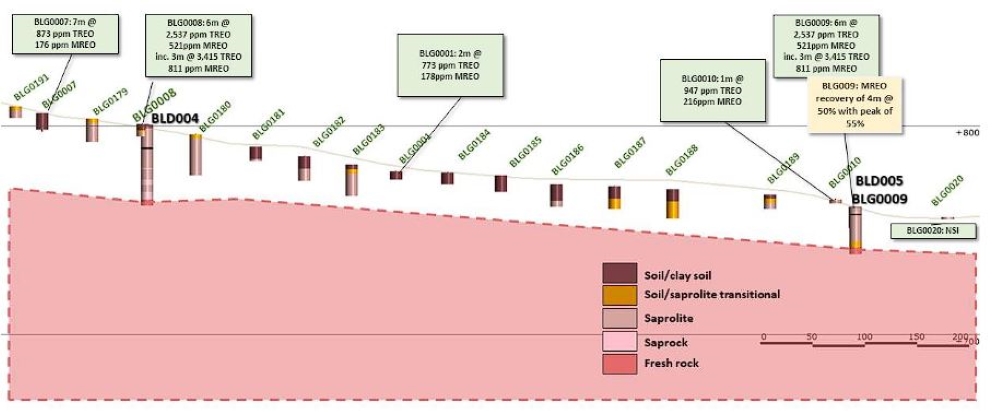You might be interested in
Mining
Explorers Podcast: Alvo Minerals teams up with Ore Investments to dine down on Palma in Brazil
Mining
REE Survival Guide Part 3 – these ASX juniors are pouring into Brazil’s rare earths scene
Mining
Mining
Special Report: Maiden diamond drilling at Alvo Minerals’ emerging high-grade Bluebush Ionic Clay REE project in Brazil has intercepted 3,779 parts per million (ppm) total rare earth oxides (TREO), with 26% containing valuable and in-demand magnetic rare earth oxides (MREO).
The importance of good percentages of MREO content for rare earth projects should not be downplayed, as they provide the highest returns of all REE minerals, especially when classified as ionic adsorption clay-hosted (IAC) projects where recovery percentages can be much higher.
These include dysprosium, terbium, neodymium and praseodymium and are used in a range of high techs – from everyday smartphones and military technologies to applications for our burgeoning clean energy transition.
Alvo Minerals’ (ASX:ALV) has confirmed thick clay horizons at the Bluebush IAC REE project, adjacent to and in the same geological setting as the tier-one, Serra Verde Ionic Clay REE project (MRE of 911Mt @ 1,200ppm TREO), believed to be the only IAC project being commissioned outside of China.
Initial drill holes at Bluebush have intersected 28m of highly weathered saprolite clay, significantly extending the depth of the clay profile – which the explorer has identified to contain high percentages of rare earth minerals due to its IAC classification.
217 auger holes and six diamond holes have been completed so far at Bluebush, with >130 auger holes and the six DD holes sent to the lab and awaiting results.
The cores show the saprolite thickness has varied from a minimum of 9.4m in hole BLD006 to 28.3m in hole BLD004, with an average interval of clay intercepted at 18.3m.
This is much deeper than the average depth of 8.3m for auger drilling completed to date across the Bluebush project.
BLD004 is just 4m away from augur hole BRL008 which delivered “exceptional” MREO values of 6m @ 2,537ppm TREO (21% MREO), including 3m @ 3,415ppm TREO (24% MREO).
BRL008’s grade started from surface and appeared to be increasing at depth, ending in 3,779ppm TREO (26% MREO).

ALV managing director Rob Smakman said it was “another outstanding milestone at Bluebush”, with confirmation that saprolite clay depth profile significantly extends below the depth profiles previously defined by auger drilling.
“The 28m of saprolite clay intersected in proximity to the exceptionally high-grade drill hole BRL008 is exciting, especially delivering this result so soon after receiving confirmation that Bluebush is a true ionic adsorption clay project with individual MREO recoveries being as high as 83%,” he said.
“With over 130 auger holes and the first batch of diamond holes now being shipped to the lab, ongoing auger and diamond drilling, regional exploration through handheld auger drilling and the initiation of the Loupe geophysical surveys, there is plenty of newsflow leading into the end of CY2023 from the Bluebush Ionic REE project.
“These diamond drill results illustrate the depths of clay horizons within the Bluebush project, which is adjacent to and on the same geological setting as the world-class Serra Verde IAC mine.”
Continuation of auger drilling is following up on the high-grade MREO zones in parallel to the diamond drilling, which ALV says will help to gain an understanding of the true depths of the saprolite clay profiles.
It’s also undertaking Loupe Portable Electromagnetic surveys across Bluebush that map the near-surface conductivity and will accelerate the mapping of the saprolite depth profile across Bluebush.
Alvo says it will take samples from the diamond drill holes for metallurgical testing to optimise recoveries using a standard ammonium sulphate solution (AMSUL) which has already shown MREO recoveries of up to 83% from previous testing.
“We intend to utilise this due diligence period to not only verify the historical results by auger drilling, but also apply systematic exploration across the tenure to better understand the potential of the project.”
This article was developed in collaboration with Alvo Minerals, a Stockhead advertiser at the time of publishing.
This article does not constitute financial product advice. You should consider obtaining independent advice before making any financial decisions.